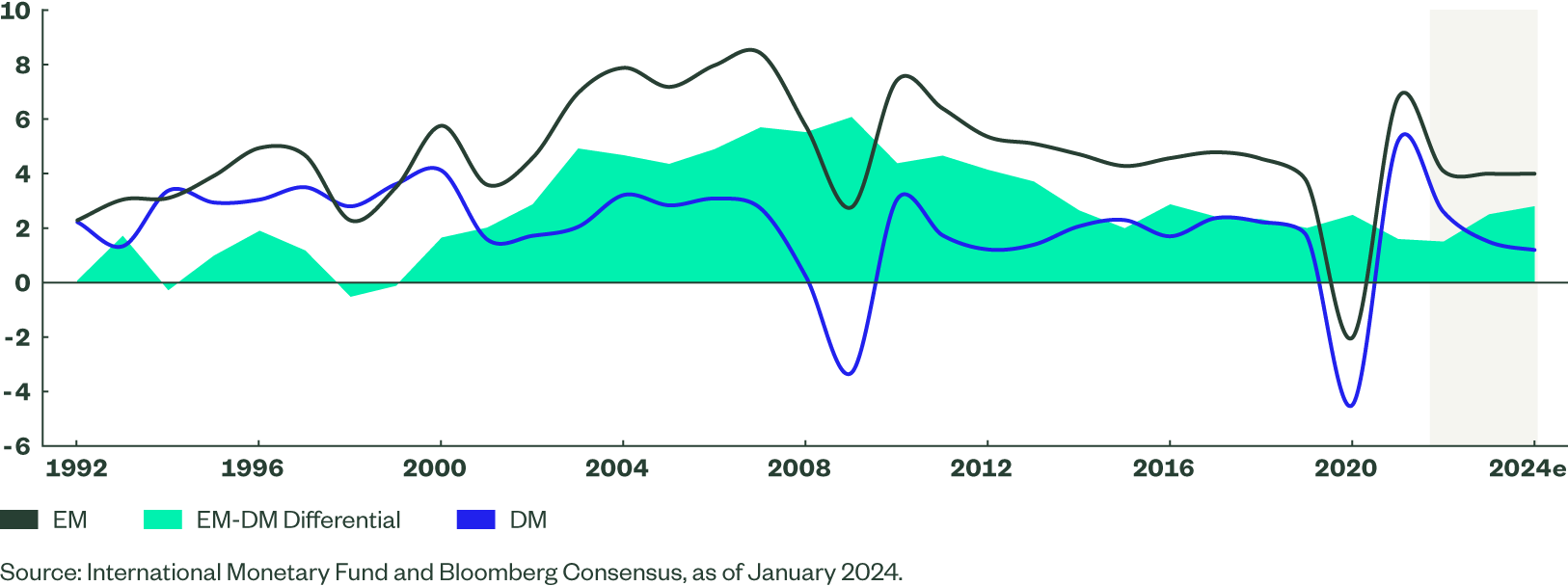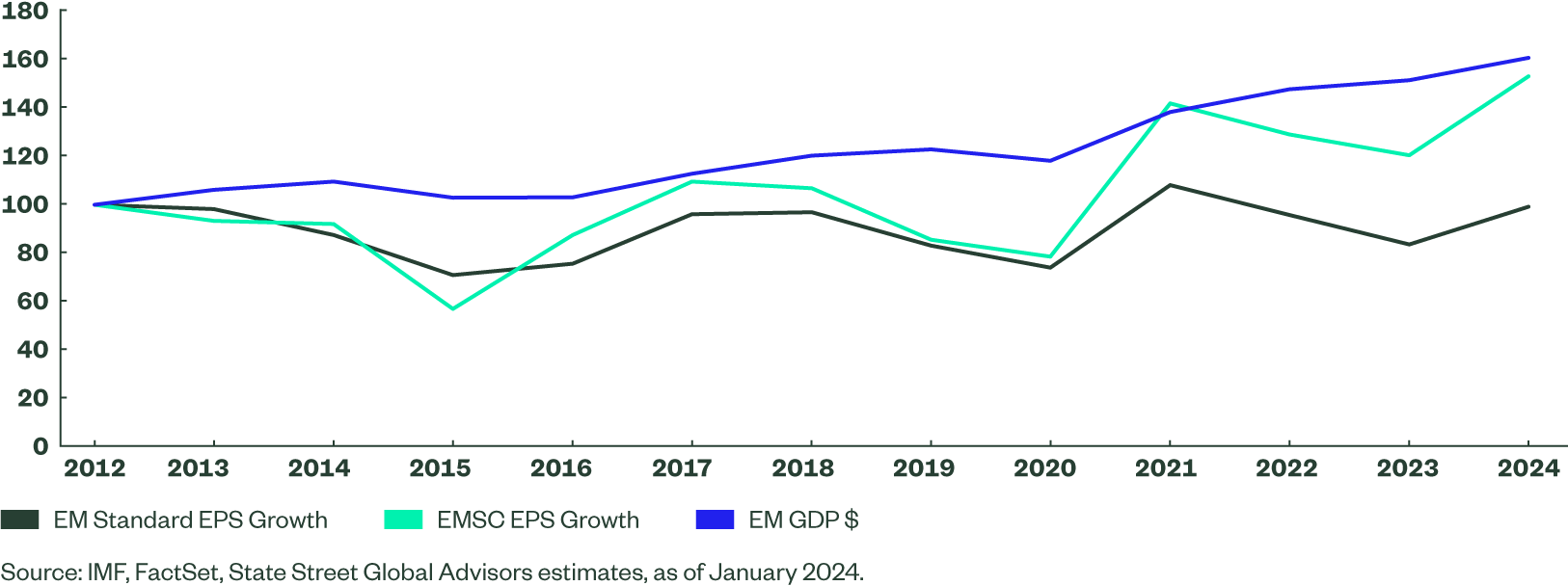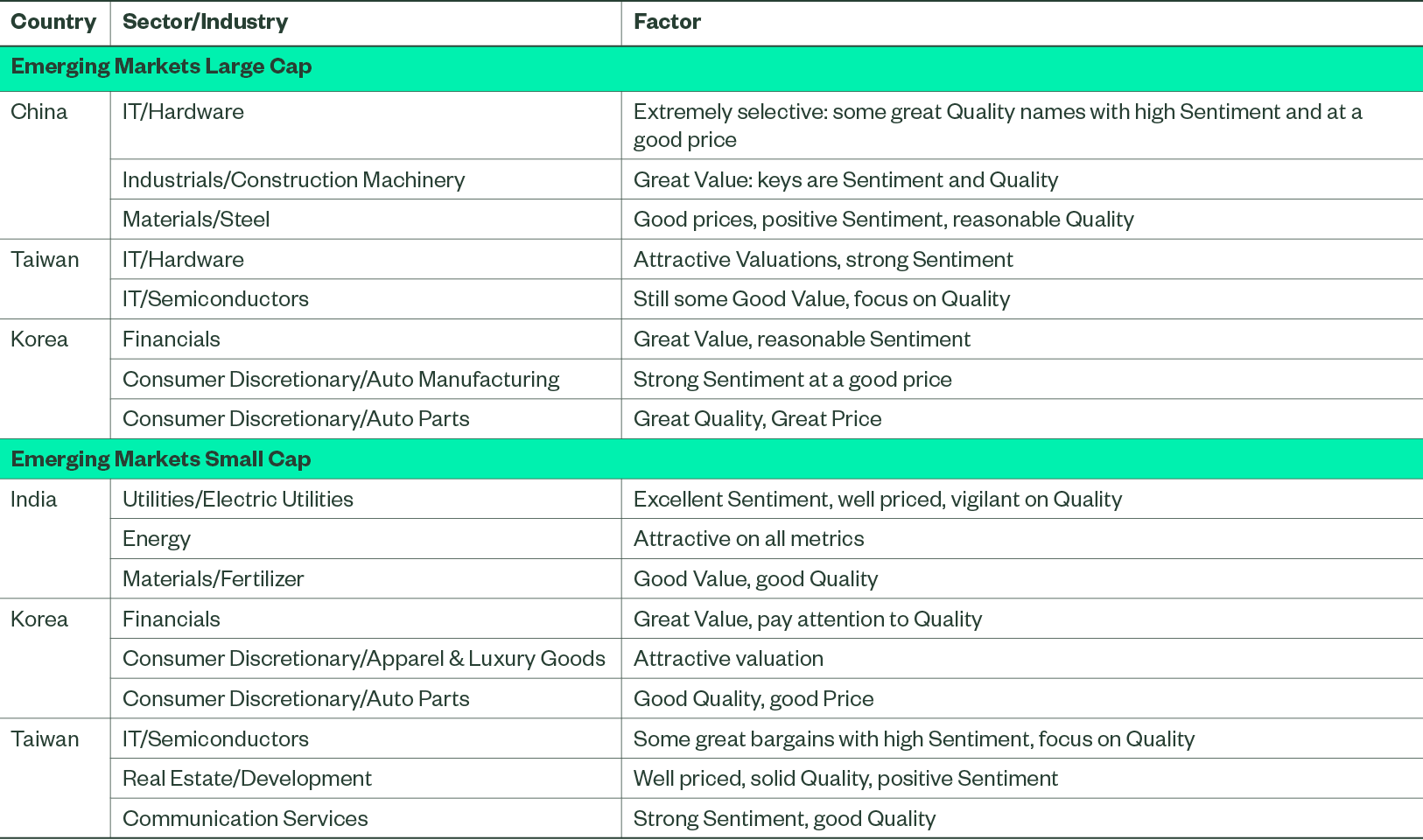Emerging Markets: Choose the Right Target
Investors are right to look to emerging markets for growth, but in this article we argue that small-cap stocks are the area to focus on in 2024. Macro themes are important to evaluate with all investments, but micro themes often are more important to selecting quality firms.
In virtually every meeting with clients interested in emerging markets (EM), the primary reason we hear for that interest is growth. Other reasons are mentioned, of course – low correlations and valuations – but growth is by far the primary one. Economic growth has propelled strong equity returns in the developed world – so much so that investors have a mindset that economic growth goes hand in hand with corporate profits. And because the developed world has issues with demography, debt, and declining trend growth – developed market (DM) economic activity may only grow at an annualized rate of between 1-2% over the medium term.* This is rather unimpressive compared with its history and versus emerging markets, which the IMF forecasts to grow by 4.1% in 2024.* And surely, the growth in EM is real. Any traveler to Shanghai, Mumbai, Doha, or Dubai will have seen unimaginable improvements over the years.
Figure 1: Emerging Markets Have Long Been the Growth Leaders

Overweight EM?
So, if growth drives earnings, is it time to go significantly overweight EM? Well, the real world is messy. First, and while this may seem painfully obvious, investors often forget that many of the largest EM firms are global. And, painfully obvious second point, as equity investors, we buy stocks – not countries. Many of the largest listed names – TSMC, Samsung Electronics, and Infosys – all impressive companies – don’t exactly represent the true economic activity of their country of listing. These types of firms are tied to global growth and face (sometimes brutal) global competition.
And developed market companies have not been asleep at the wheel. Over the past 30 years, there has been enormous change in the business lines of developed market firms. M&A and organic growth have diversified developed market companies – often getting them large EM revenue (or production) exposures.
Now, in 2024, how do we untangle this knot? The first recommendation we give to clients is to choose the right target. If you are looking for EM growth, identify those companies that are benefiting from the economic growth of the region.
Figure 2: For EM Growth, Look at Smaller-Cap Names

The graph is a bit sobering, but answers the question as to why EM large-cap returns have been underwhelming of late. We will dive into this in a future article, but the short answer is that economic growth is a necessary, but insufficient, condition for strong equity profitability (and returns).
Less Dollar Dramatics
One attractive quality of Emerging Market Small Caps (EMSC) that we particularly find compelling is the lower relative impact from the US dollar (USD). This goes hand in hand with the pure EM growth play mentioned above, because revenues in EMSC companies are driven more by local demand as opposed to global demand. Consequently, currency rates play a much smaller role than the more globally driven EM large-cap (EMLC) names. The most straightforward way to illustrate this relationship is by looking at the correlation between the twelve-month change in USD and the forward one-year estimated EPS growth rate. Using a trailing ten-year window, the correlation for EMSC is marginally negative at -0. 2, while the EMLC correlation comes in at -0. 6.
It is hard to say where USD rates go from here; certainly a more dovish stance by the Federal Reserve Board (multiple rate cuts in 2024 and decreasing balance sheet roll off) may result in some weakening of the US dollar in the short-term. However, with most if not all major central banks appearing to follow suit, it’s hard to say. And therein lies the benefit: irrespective of the direction of future USD foreign exchange rates, earnings growth of EMSC companies is more insulated from unfavorable moves.
The Case for Overweighting Emerging Market Small Caps
As investors, how should we interpret this analysis? One key conclusion would be that there are compelling reasons to increase exposure to EM small caps in one’s portfolio. This can either be done by allowing flexibility to your large cap EM manager or looking for a dedicated EMSC mandate. We have long advocated for this approach and have been budgeting between 10-20% in our standard products to improve our stock selection opportunity set and reduce the emerging market large cap index concentration problem. (Recall that Alibaba was once 9% of the index; it’s now closer to 2%). From an Investible Market Index perspective, a neutral position would be a 16% weight in EMSC. We recommend that investors take that as a starting point.
Emerging Markets: Time to be Selective
While the macroeconomic case for the broad asset class remains lackluster – and the majority of flows going into index-oriented products – we are suggesting investors rethink their exposures. Many of the large index weights – particularly in China – remain at risk to both domestic and global political risks. As one of our colleagues on the EM Fundamental team says – “cheap is the new normal in China.” However, we think it is a mistake to ignore opportunities there, but the work to find them is certainly getting harder. We recommend that investors stay diversified and avoid crowded positions.
Figure 3: Emerging Markets Factor Viewpoints

The Bottom Line
Downside risks are lessening as global economic momentum appears to be reasonably strong, albeit with downside risks for 2024. Earnings estimates remain bullish for 2024, but we must caution that some of this is base effects from 2023 downgrades. The case for a structural bull market in EM centers around a repairing of corporate profitability. While there are improvements expected in 2024, we need more signs to get broadly constructive on the whole asset class. For now, look to the smaller, growth-orientated names.